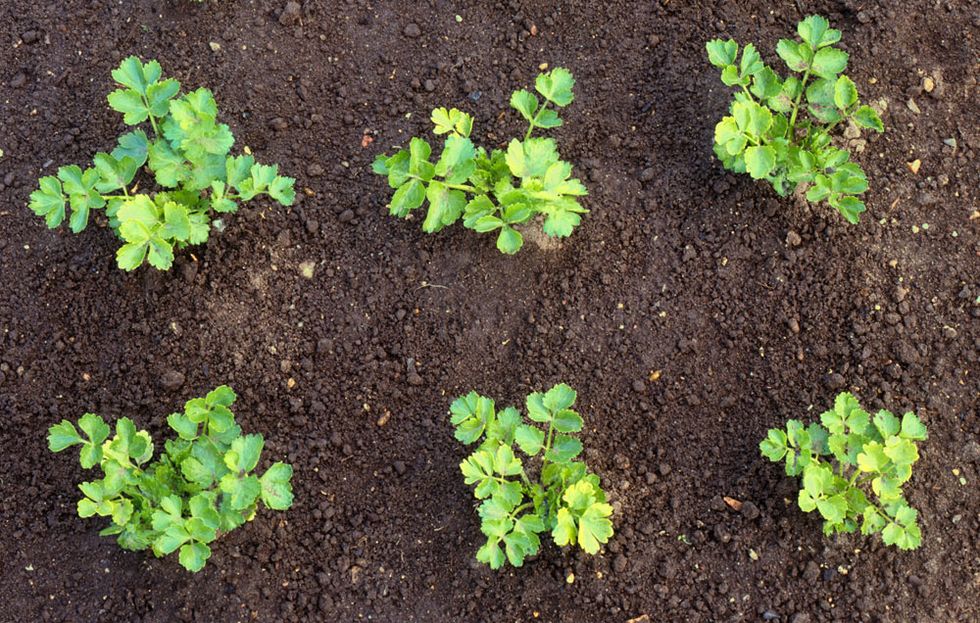Learning how to grow celery is simple. The main features this crop requires are rich soil, plenty of water, and protection from hot sun and high temperatures. Grow celery as a winter crop in the South, a summer crop in the far North, and a fall crop in most other areas.
Planting Celery
You can buy transplanted crops from nurseries, but cultivar choices expand enormously when you grow celery from seed. You can choose standard varieties such as ‘Ventura’, experiment with self-blanching types such as ‘Golden Boy’ and ‘Tango’, or try red-stalked varieties such as ‘Redventure’. For a late-summer crop, sow seeds indoors 10 to 12 weeks before the last average spring frost. Soak the tiny seeds overnight to encourage germination. Fill a container with a mix of ½ compost and ½ sand, and plant in rows 1 inch apart. Cover the seeds with a sand layer ½ inch deep, then cover the flats with damp sphagnum moss or burlap until seeds sprout.
Place in a bright spot out of direct sun, and keep the temperature at 70 to 75 degrees Fahrenheit during the day and about 60 degrees at night. Provide plenty of water and good drainage and air circulation. Transplant the seedlings into individual pots when they are about 2 inches tall. At 6 inches, harden off the plants for about 10 days, and then transplant them into the garden in a bed that’s high in organic matter (from a cover crop or added compost).
Space the plants 6 to 8 inches apart in rows 2 to 3 feet apart. Set them no deeper than they grew in pots. Water in each seedling with compost tea.
For a fall crop, also known as a second harvest, sow seeds indoors in May or June, and follow the same directions, transplanting seedlings in June or July. Provide shade in hot, humid weather.
Growing Celery
Apply several inches of mulch, and provide at least 1 inch of water a week. Gently remove any weeds that might compete for nutrients with celery’s shallow roots. Feed every 10 to 14 days with compost tea or a balanced fertilizer. If night temperatures are consistently below 55 degrees, protect plants by covering them with cloches; otherwise, the stalks become weak.
Blanching celery destroys some nutrients but prevents stalks from becoming bitter. It also protects fall crops against heavy frosts. You can grow a self-blanching variety, such as ‘Golden Self-Blanching’, or blanch conventional varieties by one of these methods:
Gradually pull the soil up around the plants as they grow, keeping the leaves exposed.
Two weeks before harvest, tie the tops together, and mound soil up to the base of the leaves.
Cover the stalks with large cans (remove both ends first), drain tiles, or sleeves made out of paper or other material.
Water carefully after setting up your blanching system, avoiding wetting the leaves and stalks, or they may rot.
Line up boards, secured with stakes, along each side of a celery row to shut out the sun.
Celery Growing Problems
Celery’s main enemies are parsley worms, carrot rust flies, and nematodes. Celery leaf tiers are tiny yellow caterpillars marked with one white stripe; control by hand picking. Attacks of tarnished plant bugs show up as black joints or brown, sunken areas.
Common diseases that affect celery crops, as well as other vegetables, include early and late blight, which both begin as small dots on the leaves, and pink rot, which shows up as water-soaked stem spots and white or pink coloration at stalk bases. Crop rotation is the best control.
Distorted leaves and cracked stems can indicate a boron-deficient soil; correct by spraying plants with liquid seaweed extract every two weeks until symptoms disappear.
Harvesting Celery
Cut the plant off just below the soil line, or cut single stalks of unblanched celery as needed. To preserve a fall crop, pull up the plants and place them in deep boxes with moist sand or soil around the roots. Store in a cool place; they will keep for several months.














